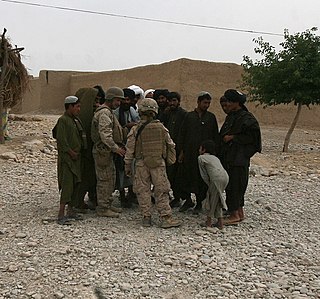Related Research Articles
Military science is the study of military processes, institutions, and behavior, along with the study of warfare, and the theory and application of organized coercive force. It is mainly focused on theory, method, and practice of producing military capability in a manner consistent with national defense policy. Military science serves to identify the strategic, political, economic, psychological, social, operational, technological, and tactical elements necessary to sustain relative advantage of military force; and to increase the likelihood and favorable outcomes of victory in peace or during a war. Military scientists include theorists, researchers, experimental scientists, applied scientists, designers, engineers, test technicians, and other military personnel.

A military, also known collectively as armed forces, is a heavily armed, highly organized force primarily intended for warfare. It is typically authorized and maintained by a sovereign state, with its members identifiable by their distinct military uniform. It may consist of one or more military branches such as an army, navy, air force, space force, marines, or coast guard. The main task of the military is usually defined as defence of the state and its interests against external armed threats.
Military doctrine is the expression of how military forces contribute to campaigns, major operations, battles, and engagements.

Military intelligence is a military discipline that uses information collection and analysis approaches to provide guidance and direction to assist commanders in their decisions. This aim is achieved by providing an assessment of data from a range of sources, directed towards the commanders' mission requirements or responding to questions as part of operational or campaign planning. To provide an analysis, the commander's information requirements are first identified, which are then incorporated into intelligence collection, analysis, and dissemination.

The Department of Defense Architecture Framework (DoDAF) is an architecture framework for the United States Department of Defense (DoD) that provides visualization infrastructure for specific stakeholders concerns through viewpoints organized by various views. These views are artifacts for visualizing, understanding, and assimilating the broad scope and complexities of an architecture description through tabular, structural, behavioral, ontological, pictorial, temporal, graphical, probabilistic, or alternative conceptual means. The current release is DoDAF 2.02.
Principles of war are rules and guidelines that represent truths in the practice of war and military operations.

The Military Staff of the European Union (EUMS) is the directorate-general of the European Union's (EU) External Action Service (EEAS) that contributes to the EU's Common Security and Defence Policy (CSDP) by providing strategic advice to the High Representative (HR/VP) and commanding operations through its Military Planning and Conduct Capability (MPCC) operational headquarters. From the end of 2020 the MPCC will also be capable of running executive operations of up to 2500 troops, i.e. the size of one battle group, as well as 3 non-executive missions.

The United Kingdom's Strategic Command (StratCom), previously known as Joint Forces Command (JFC), manages allocated joint capabilities from the three armed services.
The Defence of Australia Policy was Australia's dominant defence policy between 1972 and 1997. The policy was focused on the defence of continental Australia against external attack. The Australian Defence Force was tailored to defending Australia rather than developing capabilities to operate outside Australian territory.
The Australian Defence Organisation (ADO), also known as simply Defence, is an Australian Government organisation that consists of both the Australian Defence Force (ADF) and the Department of Defence (DoD). The ADO's collective aims are to "defend Australia and its national interests" and "protect and advance Australia's strategic interests".

The Vice Chief of the Defence Force (VCDF) is the military deputy to the Chief of the Defence Force (CDF) of Australia, and acts as the CDF in his absence under standing acting arrangements. Vice Admiral David Johnston, the incumbent VCDF, has held the position since 5 July 2018.
Capability management is a high-level management function, with particular application in the context of defense.

The Helsinki Headline Goal was a military capability target set for 2003 during the December 1999 Helsinki European Council meeting with the aim of developing a future European Rapid Reaction Force. There was much interest in the idea of a single EU military force, and inexact characterisations of the initiative led to imprecise journalistic depictions about a unified European army.
Intelligence dissemination management is a maxim of intelligence arguing that intelligence agencies advise policymakers instead of shaping policy. Due to the necessity of quick decision-making in periods of crisis, intelligence analysts may suggest possible actions, including a prediction of the consequences of each decision. Intelligence consumers and providers still struggle with the balance of what drives information flow. Dissemination is the part of the intelligence cycle that delivers products to consumers, and intelligence dissemination management refers to the process that encompasses organizing the dissemination of the finished intelligence.
DOTMLPF is an acronym for doctrine, organization, training, materiel, leadership and education, personnel, and facilities. It is used by the United States Department of Defense and was defined in the Joint Capabilities Integration Development System, or JCIDS Process as the framework to design what administrative changes and/or acquisition efforts would fill a capability need required to accomplish a mission. Because combatant commanders define requirements in consultation with the Office of the Secretary of Defense (OSD), they are able to consider gaps in the context of strategic direction for the total US military force and influence the direction of requirements earlier in the acquisition process, in particular, materiel.
A strategic military goal is used in strategic military operation plans to define the desired end-state of a war or a campaign. Usually it entails either a strategic change in an enemy's military posture, intentions or ongoing operations, or achieving a strategic victory over the enemy that ends the conflict, although the goal can be set in terms of diplomatic or economic conditions, defined by purely territorial gains, or the evidence that the enemy's will to fight has been broken. Sometimes the strategic goal can be to limit the scope of the conflict.
Capability management is the approach to the management of an organization, typically a business organization or firm, based on the "theory of the firm" as a collection of capabilities that may be exercised to earn revenues in the marketplace and compete with other firms in the industry. Capability management seeks to manage the stock of capabilities within the firm to ensure its position in the industry and its ongoing profitability and survival.

Federated Mission Networking (FMN) is a significant initiative to help ensure interoperability and operational effectiveness of the North Atlantic Treaty Organization, it is a key contribution to the Connected Forces Initiative, helping Allied and Partner forces to better communicate, train and operate together. This includes the NATO Command Structure as well as the NATO Force Structure. The purpose of FMN is ultimately to support Command, Control, Communications, Computers, Intelligence, Surveillance and Reconnaissance (C4ISR) and decision-making in operations by enabling a rapid instantiation of mission networks. Including the NATO Command Structure, 37 nations have joined the FMN initiative as so called "FMN Affiliates" and work together under the FMN Framework Process to coordinate the design, development and delivery of operational and technical capabilities required to conduct net-centric operations. Each development increment is referred to as an "FMN Spiral". The respective requirements, architecture, standards, procedural and technical instructions are documented in so called "FMN Spiral Specifications". FMN Spiral Specifications are based on well known standards and best practices, hence supported by most off-the-shelf products and vendor neutral. TACOMS standards and profiles specify a common, technology and topology independent network interoperability layer for federated mission networks. There is also a rolling 10-year FMN Spiral Specification Roadmap of the envisioned future capabilities. At the same time, the Coalition Interoperability Assurance and Validation (CIAV) process ensures that current interoperability issues are being identified and fed back into FMN capability development.
The Defence Planning Committee is a senior decision-making organisation created on 19 April 2018 by the Government of India.

This article outlines the present structure of the European Union's Common Security and Defence Policy (CSDP), a part of the Common Foreign and Security Policy (CFSP) based on articles 42–46 of the Treaty on European Union (TEU). Article 42.2 of TEU states that the CSDP includes the 'progressive framing' of a common Union defence policy, and will lead to a common defence, when the European Council of national heads of state or government, acting unanimously, so decides.
References
- Hinge, Alan, Australian Defence Preparedness: Principles, Problems and Prospects : Introducing Repertoire of Missions (ROMINS) a Practical Path to Australian Defence Preparedness, Australian Defence Studies Centre, Canberra, 2000
- FM 100-61 Armor and mechanized-based Opposing Force Operational Art, Headquarters, Department of the Army, Washington, DC, 26 January 1998
- Newell, Clayton R., Framework of Operational War, Routledge, 1991